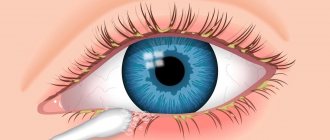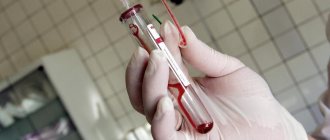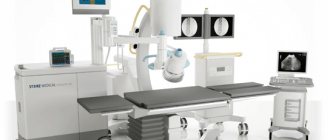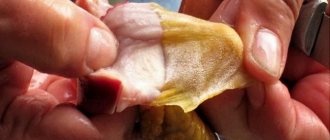The urachus (urinary duct) is the tube between the top of the bladder and the navel through which fetal urine drains into the amniotic fluid. The urachus is completely overgrown 2-12 months after the birth of the child, forming a ligamentum umbilicale medium.
Click on pictures to enlarge.
Drawing. Congenital anomalies of the urachus: normal ligamentum umbilicale medium (1), complete non-closure of the urachus - vesico-umbilical fistula (2), non-closure of the urachus in the area of the umbilical ring - umbilical fistula (3), non-closure of the urachus in the middle part - urachus cyst (4), non-closure urachus at the bladder - diverticulum of the apex of the bladder (5).
Vesico-umbilical fistula on ultrasound
With complete closure of the urachus, a vesico-umbilical fistula is formed, which opens in the area of the umbilical ring. Due to contact with urine, the skin around the navel is irritated. In congenital vesico-umbilical fistula, due to the blood supply from the urachus artery, granulations (remnants of the umbilical cord) remain on the navel. Granulation does not occur if the vesico-umbilical fistula opens due to obstructions to the outflow of urine - a tumor in the pelvis, posterior urethral valves, urethral strictures, phimosis, etc. In such cases, the vesico-umbilical fistula can close on its own when the problem is eliminated.
Drawing. From birth, a baby's navel discharges a straw-colored liquid with the smell of urine; when pressing on the bladder, the outflow of urine from the navel increases; the skin around the navel is irritated, granulation. Ultrasound reveals a hypoechoic tubular structure from the apex of the bladder to the umbilicus. Diagnosis: Vesico-umbilical fistula. In such cases, there is a high risk of developing a urinary tract infection.
Types of pathology
The urachus is part of the urinary bladder, so its cystic formation is often called a bladder cyst.
The fetal excretory urinary duct allows all fetal secretions to be discharged into the amniotic fluid. Normal fetal development causes fusion of the urachus by 5 months of pregnancy. In place of the overgrown duct, the middle umbilical ligament appears.
Formed in the embryonic period, the pathology can be detected at any stage of life: a urachal cyst appears in children and adult patients.
The anomaly is divided into the following types:
- Closed type. The pathology of this type is characterized by a closed cystic capsule with fluid, without the formation of a fistula;
- Open (umbilical, vesico-umbilical cyst). This type involves the formation of a fistula, as a result of which embryonic biological fluids entering the walls of the abdomen irritate its surface. Through the fistula, not only embryonic secretions, but also various harmful microbes enter the abdominal cavity, which can lead to the occurrence of a pathological process.
Umbilical fistula on ultrasound
Non-closure of the urachus in the area of the umbilical ring manifests itself in the first days after birth - a weeping navel, maceration of the skin. An umbilical fistula at a later date indicates drainage of an infected urachal cyst.
It is important to distinguish between patent urachus, umbilical vein and vitelline duct. When the umbilical vein is not closed, the discharge is bloody. When the vitelline duct is not closed in the navel, there is a bright red tumor, the skin is severely irritated by alkaline discharge.
Drawing. A man complains of purulent discharge from the navel. On ultrasound, just below the navel there is a heterogeneous rounded lesion, which communicates with the umbilical fossa due to a hypoechoic tubular structure; connection with the bladder is not determined; blood flow in the surrounding tissues is slightly increased. Diagnosis: Infected urachal cyst, umbilical fistula.
Complicated urachal cysts. Features of diagnosis and treatment in adult patients
V.V. Bazaev, N.V. Bychkova, A.A. Morozov, A.P. Morozov, E.V. Smirnova
Information about authors:
- Bazaev V.V. – Doctor of Medical Sciences, leading researcher at the Department of Urology, Moscow Regional Research Clinical Institute named after. M.F. Vladimirsky; Moscow, Russia; RSCI AuthorID 600043
- Bychkova N.V. – Candidate of Medical Sciences, Associate Professor, Senior Researcher at the Department of Urology, Moscow Regional Research Clinical Institute. M.F. Vladimirsky; Moscow, Russia; RSCI AuthorID 762291
- Morozov A.A. – urologist of the Department of Urology of the State Budgetary Healthcare Institution of Moscow Region Monika named after. M.F. Vladimirsky; Moscow, Russia
- Morozov A.P. – Doctor of Medical Sciences, urologist of the Department of Urology of the State Budgetary Healthcare Institution of the Moscow Region Monika named after. M.F. Vladimirsky; Moscow, Russia
- Smirnova E.V. – clinical pharmacologist of the State Budgetary Healthcare Institution MONIKI named after. M.F. Vladimirsky; Moscow, Russia
INTRODUCTION
A urachus cyst is a malformation of embryogenesis, with the formation of a closed cavity in the urinary duct containing serous fluid. The incidence is up to 42% of all anomalies of the urinary canal. A urachal cyst occurs due to the lack of obliteration of the duct in its middle part, which remains in this form throughout life. Small cysts can remain asymptomatic for a long time. Large cysts are characterized by pain, palpable formation of the abdominal wall, and micturition disorders. Clinical symptoms appear with complications: perforation, fistula formation, cyst infection. Urachal cysts are diagnosed using ultrasound, multislice computed tomography (MSCT), cystoscopy, and in the presence of a fistula, fistulography [1].
MATERIALS AND METHODS
Symptoms of a urachus cyst
A patient with a complicated urachus cyst complains of pain in the lower abdomen, discomfort, dysuria, and a palpable mass. When an external fistula forms, there is serous-purulent discharge from the navel, so skin maceration and dermatitis are often present. Emptying of a suppurating urachus cyst into the bladder is clinically manifested as acute cystitis. In adults, a urachal cyst is detected during examination for gross hematuria. In addition, in adults, possible malignancy of the embryonic urinary canal poses a danger; in 90% adenocarcinoma develops. The risk of having a neoplastic process increases with age. According to an analysis of the literature, 10-30% of cases of bladder cancer begin at the mouth of the urinary duct.
Diagnostics
The diagnosis is made on the basis of complaints, anamnesis, objective and instrumental examination. Laboratory tests are necessary to monitor the degree of associated inflammatory phenomena. Ultrasound, MSCT, magnetic resonance imaging (MRI), fistulography, cystoscopy are used to clarify the diagnosis and tactics of surgical treatment.
Treatment of urachus cyst
In childhood, when the disease manifests itself in 98% of patients, even if the rudimentary cyst is complicated by fistula formation, conservative treatment tactics and dynamic observation are possible. With growing up, complete obliteration of the urachus may occur, despite the concomitant inflammatory process.
Urachal disease is rare in adult patients. Differential diagnosis of urachal diseases in adults by visual (cystoscopy), cytological and histological methods may not give a convincing result. Therefore, the diagnosis is clarified during surgery or in the postoperative period based on the results of histological examination. The scope of surgical interventions, according to most modern authors, should include excision of the urachal cyst, as well as partial cystectomy (resection of the bladder) [1–7].
Despite the general morphology of a congenital urachus defect, each case with a complicated urachus cyst has specific clinical course, so differential diagnosis is always necessary, which is described in the observations below.
Clinical observation No. 1
Patient S., 65 years old, was in the urology department of the State Budgetary Healthcare Institution MONIKI named after. M.F. Vladimirsky from 08/19/2020 to 09/11/2020 with a diagnosis of: Congenital anomaly of the urinary system. A suppurating urachus cyst. Diabetes mellitus type 2. Obesity 2 tbsp. Stage 2 hypertension. Arterial hypertension 3 degrees, 4 risk of cardiovascular complications. Umbilical hernia. Combined aortic valve disease (moderate stenosis and insufficiency). Condition after blunt trauma to the abdomen and chest with a fracture of 7-10 ribs on the left.
She was admitted with complaints of periodic pain and discomfort in the lower abdomen. From the anamnesis it is known that 2 weeks after a blunt injury to the abdomen and chest with a fracture of 7-10 ribs on the left, a mild amount of blood was noted in the urine. Increase in body temperature to 37.5 °C. Ultrasound revealed a cystic formation of the urachus, up to 6 cm in size. The kidneys and upper urinary tract were unremarkable. Cystoscopy revealed bullous swelling of the mucosa in the area of the apex of the bladder measuring 3x4 cm, with hyperemia of the mucosa along the periphery. When pressing over the pubis, the release of turbid contents from the area of the apex of the bladder, covered with bullous edema, was noted. Cytologically – “groups of reactive urothelium” with inflammatory changes. Urine culture showed E. Coli 104 CFU/ml, S. epidermidis 103 CFU/ml. with sensitivity to ceftazidime, imipenem, gentamicin, amikacin, furagin, fosfomycin.
MRI revealed a volumetric fluid formation in the urachus area with reactive inflammatory changes.
MSCT diagnosed the presence of an additional formation at the site of typical localization of the urachus with signs of infiltration of the surrounding tissue. Umbilical hernia (Fig. 1-3).
Rice. 1. Ultrasound of the bladder of patient S. Fig. 1. Ultrasound of the bladder of patient S.
Rice. 2-3. MSCT of the bladder of patient S. Fig. 2-3. MSCT of the bladder of patient S.
The patient underwent an open operation: partial median laparotomy with excision of the umbilical hernia, the contents of which were a section of the greater omentum. When dissecting the aponeurosis and revision, dense infiltration of the aponeurosis and muscles of cartilaginous density was revealed. Adjacent to the peritoneum from the side of the abdominal cavity is a formation of stony density without clear boundaries measuring 8x10 cm, in a single conglomerate with the apex of the bladder - it is assumed that this is a tumor of the urachus. With significant technical difficulties, a circular resection of the bladder in the area of its apex was performed en bloc with the tumor within healthy tissue using an ultrasonic scalpel. Suturing the bladder wall with a 2-row suture and installing drainage in the pouch of Douglas. A Foley catheter is inserted into the bladder. When opening the specimen, a cystic cavity with cloudy exudate and bullous edema of the tissue was discovered.
Histological examination revealed that the cyst wall was represented by young and maturing granulation tissue with focal lymphoplasma cell infiltration. No tumor growth was detected.
The postoperative course was complicated by decompensation of diabetes mellitus and suppuration of the postoperative wound. This required continued insulin therapy, antibacterial therapy (ABT) with ceftriaxone, meropenem, amikacin, local administration of panbacteriophage [8], with complex physiotherapeutic treatment. The patient was discharged with recovery.
The peculiarity of this observation was that the uncomplicated urachal cyst had an asymptomatic course in a patient under 65 years of age. After an abdominal injury, probably with a partial rupture of the urachus and the formation of a paravesical hematoma, suppuration developed, which was manifested by local symptoms. Preoperative diagnostics, including cystoscopy, ultrasound, CT and MSCT, made it possible to make a fairly accurate preoperative diagnosis, but did not give a complete picture of the extent of the infiltrate. A purulent urachal cyst may also contain a tumor. Therefore, the final stage of diagnosis is always surgery and subsequent histological examination. Taking into account the above, from our point of view, during surgical intervention, the infiltrated tissues surrounding the cyst should be excised as much as possible and the upper hemisphere of the bladder should be resectioned (Fig. 4).
Rice. 4. Macropreparation of a removed urachal cyst in patient S. Fig. 4. Macrodrug of a removed urachus cyst of patient S.
Clinical observation No. 2
Patient M., 62 years old, was in the urology department of the State Budgetary Healthcare Institution MONIKI named after. M.F. Vladimirsky from July 13, 2020 to July 23, 2020. Admitted with a diagnosis of bladder tumor. Stage 2 hypertension. Arterial hypertension 2 degrees, risk of cardiovascular complications 2.
It is known from the anamnesis that a preclinical examination with ultrasound revealed a mass formation in the bladder. MSCT with intravenous enhancement, performed at the place of residence, diagnosed a cystic formation measuring up to 45x32x54 mm in the anterior wall of the bladder with cords along the urachus, with accumulation of a contrast agent. On MRI, in the anterior wall of the bladder, in the area of the apex there is a solid formation accumulating a contrast agent, with cavity inclusions, which is characteristic of necrosis or disintegrating tumor, completely involving the wall of the bladder measuring 49x56x72 mm with extension into the paravesical tissue with diligence (possibly invasive height) to the muscles of the anterior abdominal wall. There was an increase in the inguinal and external iliac lymph nodes up to 10 mm.
At MSCT at the State Budgetary Healthcare Institution of the Moscow Region MONIKI named after. M.F. Vladimirsky - a picture of a voluminous, probably extravesical formation with signs of invasion into the anterosuperior wall of the bladder - a urachus tumor. There are signs of involvement in the process of one of the loops of the small intestine, the proximal part of the sigmoid colon (Fig. 5, 6).
Rice. 5. MSCT of the abdominal organs and retroperitoneal space of patient M. Fig. 5. MSCT of the abdominal and retroperitoneal organs of patient M.
Rice. 6. MSCT of the abdominal organs and retroperitoneal space of patient M. Fig. 6. MSCT of the abdominal and retroperitoneal organs of patient M.
In a cytological study of urine, no cells with signs of atypia were found. Cystoscopy revealed signs of deformation of the apex of the bladder with the presence of a tumor-like formation, up to 5 cm in diameter, protruding into the lumen of the bladder. The mucous membrane over the formation is covered with bullous edema. According to a pinch biopsy, there are fragments of the bladder mucosa with edema, plethora, and von Brunn's nests.
There is no tumor growth. At the same time, a percutaneous puncture biopsy of the formation was performed: examination of the obtained fragments revealed fibro-fatty tissue with pronounced inflammatory infiltration, and no tumor growth was also detected. According to the histologist, the differential diagnosis should be made between a urachus cyst with active inflammation and a chronic abscess.
Given the involvement of the colon in the process, the patient underwent a colonoscopy. Diverticula of the sigmoid colon without signs of inflammation and a polyp of the transverse colon were detected. An extended biopsy was performed, and histological examination revealed a tubular adenoma of the colon.
After the examination, the patient underwent open surgery - lower median laparotomy. Removal of a tumor of the urachus and superior hemisphere of the bladder. Resection of the small intestine. Access to the abdominal cavity was closed by a woody density infiltrate measuring 8x10 cm involving the small and sigmoid colon, growing into the peritoneum of the anterior abdominal wall. To gain access to the lower abdominal cavity, it was decided to perform a small bowel resection. The mesentery of the small intestine was mobilized and an 8 cm long section of it was resected at a distance of 20 cm from the ileocecal angle. It was revealed that the wall of the sigmoid colon was loosely connected with the infiltrate; it was separated from the infiltrate. An entero-enteroanastomosis was performed using a side-to-side hardware suture. The bladder wall is sutured with a 2-row continuous vicryl suture. A drainage was installed in the pelvis and a Foley catheter in the bladder.
Histological examination of the dissected infiltrate resected as a single block revealed: a fragment of the bladder wall, a fragment of the ileum and a cystic formation intimately fused to the bladder wall. The wall of the cyst was represented by fibrous tissue with pronounced purulent-productive inflammation, spreading to adjacent areas of the walls of the bladder, small intestine, and mesentery of the colon. There were extensive sharp ulcers on the inner surface of the cyst wall. Areas of the lining represented by unidentifiable epithelium, in the lumen of the cyst - fibrinous-purulent exudate, drusen of actinomycetes. The postoperative course is smooth. The catheter was removed after control cystography 14 days later. Urination has returned. The wound healed by primary intention. Antibacterial therapy was carried out in accordance with the recommendations for the treatment of actinomycosis of the Sanford Handbook of Antimicrobial Therapy version 2021 (recommendations for antibacterial therapy of actinomycosis dated May 16, 2021): initial therapy with Ceftriaxone 2 g/day intravenously for 2 weeks with a further transition to amoxicillin 2 g 2 times a day for 4 weeks, followed by replacement with doxycycline (as tolerated) at a dose of 100 mg 2 times a day for up to 6 months [9].
Rice. 7. Macropreparation of the infiltrate removed as a single block, including a cystic formation of the urachus, a fragment of the ileum, and a resected part of the bladder of patient M. Fig. 7. Macrodrug of an infiltrate removed in a single block, including cystic formation of the urachus, a fragment of the ileum, a resected part of the bladder of patient M.
DISCUSSION
In the first clinical observation, a complicated urachal cyst simulated a malignant neoplasm of the bladder. Visual differential diagnosis of a suppurating urachal cyst with its possible malignant neoplasm directly during the operation was complicated by secondary tissue changes involving neighboring organs. A feature of the second clinical observation was also the detection of actinomycosis, which probably provoked inflammatory changes in the urachus cyst. This manifested a clinical picture and required radical surgical treatment.
Common features of clinical observations were the difficulties of prompt access to a space-occupying urachal formation, due to the presence of a massive inflammatory peri-process, which can always be mistaken for a malignant neoplasm of the urachus. The final diagnosis of the patients was made after a histological report.
In such cases, in our opinion, the use of laparoscopic technology is not justified, since the use of a radical method requires excision of all infiltrated tissues, the boundaries of which are easier to determine during open surgery. Involvement of the muscles of the anterior abdominal wall and aponeurosis makes it difficult to close the surgical wound, which does not exclude the use of synthetic mesh implants.
CONCLUSIONS
Complicated urachal cysts in adults require radical surgical treatment. They are characterized by the presence of secondary inflammatory changes in surrounding organs and tissues, which complicates the differential diagnosis with a possible urachus tumor. In this case, it is necessary to perform resection of adjacent organs within healthy tissues. The final diagnosis is made after histological examination.
LITERATURE
- Poddubny I.V., Isaev Y.A. Anomaly of the urinary duct in children. Russian Bulletin of Pediatric Surgery, Anesthesiology and Reanimatology 2015; (2). .
- Lopatkin N.A. Urology. National Guide, 2009. .
- Razin M.P., Galkin V.N., Sukhikh N.K. Pediatric urology-andrology: textbook, 2011. .
- Nikolsky A.V. Majidov S.A. Clinical observation – surgical treatment of urachus cyst. Urological statements 2021. .
- Ueno T, Hashimoto H. Urachal anomalies: ultrasonography and management. J Pediatr Surgeri 2003(38):1203-1207.
- Snyder Ch.L. Current management of umbilical abnormalities and related anomalies. Sem Pediatr Surg 2007(16):41-49.
- de La Taille A, Biserte J, Vankemmel O, et al. Urachalremnants: excision or survelance? Apropos of 3 cases and review of literature. J.Urology 1997.Vol.103. P. 56-58.
- Vasiliev A.O., Zaitsev A.V., Kalinina N.A., Shiryaev A.A., Kim Yu.A., Pushkar D.Yu. Bacteriophages in the treatment of lower urinary tract infections. Consilium Medikum 2021. Vol 21(7):38-41. .
- Gilbert MD, David N (Editor), Chambers MD, Henry F (Editor), Eliopoulos MD, George M (Editor), Saag MD, Michael S (Editor) & 1 more. The Sanford Guide to Antimicrobial Therapy 2021 (50th edition).
Topics and tags
Reconstructive urology
Magazine
Journal "Experimental and Clinical Urology" Issue No. 4 for 2020
Comments
To post comments you must log in or register
Urachal cyst on ultrasound
If the urachus is obliterated at both ends, and there is space in the intermediate part, then we can talk about a urachus cyst. Paravesical cysts often remain connected to the bladder. Isolated intermediate cysts can reach large sizes. Some peri-umbilical cysts are located inside the navel and communicate with it.
Urachal cysts are usually asymptomatic until they become infected. The most common pathogens are Staphylococcus, E. coli, Pseudomonas and Streptococcus. Often accompanied by fever, pain and urinary problems. Purulent contents may spontaneously burst into the navel or bladder. In rare cases, an infected cyst is emptied intraperitoneally, and then signs of peritonitis appear.
Drawing. An ultrasound scan along the midline of the abdomen, halfway from the navel to the pubis, reveals an avascular, anechoic, round formation with a clear and even contour, size 14x13x11 mm; comes into contact with the dome of the filled bladder; after mictation the shape and size do not change. Diagnosis: Urachal cyst, uncomplicated.
Causes of pathology
Experts cannot reliably determine the root cause of the pathology. A number of experts are inclined to believe that the cause of urachal cysts in men, women and children is abnormal intrauterine development.
An inflammatory process may occur in the duct due to:
- Umbilical fistula (hole). This pathology is caused by non-closure of the part of the duct closest to the navel. In this case, urine is released into the umbilical area, causing regular irritation. Pathogenic microorganisms can penetrate through the hole, triggering an infectious-inflammatory process;
- Infection of the duct with pathogenic bacteria from the bladder. This situation occurs when the organ is damaged by infections of the genitourinary system;
- The inflammatory process can occur during pregnancy. The growing uterus can put pressure on the bladder, causing inflammation.
According to the observations of specialists, urachal cysts are 3 times less common in women than in the male population. The cystic formation may not manifest itself for a long time and may not increase in size. The hidden dynamics of pathology often makes it possible to detect it in adulthood.
Bladder apex diverticulum on ultrasound
Usually, an asymptomatic diverticulum of the bladder apex is discovered accidentally when an infection occurs. Abdominal pain and frequent painful urination, hemturia and pyuria appear. Cystoscopy determines the entrance to the urachus, from which pus is released.
Drawing . A boy complains of severe pain in the lower abdomen; a general urine test reveals hematuria and leukocyturia. Ultrasound reveals a tubular hypoechoic structure that begins just below the navel and flows into the dome of the bladder. Diagnosis: Inflammation of the diverticulum of the apex of the bladder.
Take care of yourself, Your Diagnosticer !
Tags: lectures bladder ultrasound










